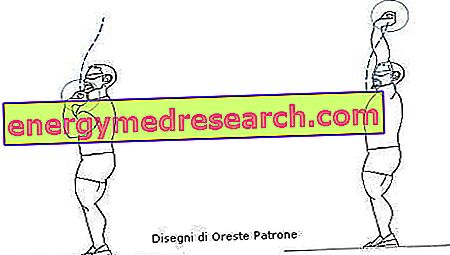Edited by Roberto Rillo - Book Author: Calisthenics BodyBuilding
A very important muscle group for a massive overall appearance is represented by deltoids, but unfortunately few other muscle groups are so difficult to develop. Perhaps only the calves and forearms have similar difficulties, so the first answer could be: it is a genetic question. This in part is certainly true especially for the deltoids or rather for what is under the deltoid: a subject A with a good achromial distance certainly shows a better aspect of the shoulders than that of a subject B with narrow shoulders; and subject B cannot claim to develop several centimeters of the deltoid's lateral head to get to have broad shoulders like those of A.
The genetic condition of having narrow shoulders must be accepted as much as that of being tall or short, but this must not prevent the possibility of training the deltoids profitably in the best possible way.
Anatomically, the deltoids consist of three heads: frontal, lateral and posterior that originate respectively from the clavicle, from the acromion of the scapula and from the spine still of the scapula. All three garments converge into a single tendon that fits over the humerus. The function of the three frontal, lateral and posterior ends is to move the arm forward, laterally and backwards, but not alone: in each of these movements the heads of the deltoids are always assisted by other muscles. In other words, it is not possible to completely isolate the action because they always work in synergy with the breastplate, the trapezius, the dorsal and the large round. In physics a type of lever such as that of the shoulder is called disadvantageous in that the power (deltoid muscle) is placed near the fulcrum (articulation) and far from the resistance (arm with possible weight). A further technical logistic problem is therefore added: a large weight cannot be used and if used being excessive for the deltoid it is immediately bypassed on the other synergistic muscles, first of all the trapezius.
Despite the slow forward in its versions, standing, sitting, with barbell and dumbbell is one of the exercises considered fundamental for the shoulders, I believe that a) from a bio-mechanical point of view it is a second choice exercise and b) it is commonly performed wrongly.
a) If we analyze the exercise, we see that the barbell from the clavicles (starting position) is raised above the head until the arms are completely relaxed (arrival position). During the trajectory the deltoids, pectorals, trapezius, large round and triceps intervene. But our deltoids work concentrically only until the arms are parallel to the ground and perpendicular to the torso; beyond this position the deltoids contract a little more but in a very reduced range, after which they remain fixed isometrically while the rest of the distension is carried out concentrically by the trapezius and triceps. Therefore for each repetition of slow forward we will have only about half a concentric movement that produces hypertrophy on the deltoid.
b) The commonly performed execution of this exercise, both for its descent from powerlifting, and for the tendency of commercial gyms to convey on the multy power, requires that the balance starting from the base of the neck travels a vertical trajectory above the head and perpendicular to the ground. This is achieved by pushing the head back and bringing the torso, through the lower back arch, just below the barbell. In this way the balance wheel can travel along a vertical trajectory without obstacles and which, thanks also to the minimum dissipation of stabilizing forces, allows consistent rises.
However, this execution completely shifts the overload from the target muscles (the deltoids) to other muscles (pectorals and triceps) with negative discharge on the lower back. Then, sitting on a 70 ° -90 ° inclined bench, the exercise essentially becomes a duplication of the incline bench!
Instead the bust should be kept perfectly erect with the lordotic curve of the flattened spine by retroversion of the pelvis. The head must remain straight and not hyper-extended, with the right eye in front of him. With this attitude we hold the barbell at the level of the clavicles and raise it above the head ... ops !? I forgot to tell you, watch your chin !!!!! The bar with the new trim and the head straight, will no longer be able to traverse a vertical trajectory and will hit you on the chin! And this is the key to the exercise or at least the way to make it more productive for the deltoids. The barbell will have to rise above the head making a trajectory similar to a parabola.

The correction to the classic execution of the slow forward, is however not sufficient to fully affect the deltoids.
The slow Scott, would be a better choice. The exercise adopts some stratagems: first the dumbbells are used in order to have the maximum articular excursion, then starting with the dumbbells in front of the chest they make themselves rotate to the side and then pushing behind the elbows they stretch the arms, but not completely to minimize triceps surgery. In this way the deltoid is totally worked in a wider range of motion. We must, however, fix our shoulders well, avoiding that with tiredness we get up and produce a sort of shake. The shoulders must remain low and recessed. We must get used to feeling the trapezium fixed and the deltoid "mobile". Think of a boxer who with steady shoulders continuously leans forward and to the side of his arms. This trick of fixing the trapezius avoiding the shake should be applied at most to the side lifts, which remain, from an anatomical-functional point of view, the best exercise for the deltoids.
So go back to the gym and do the shoulder exercises correctly, then listen to what your deltoids have to say: they might scream at you that they finally worked.



